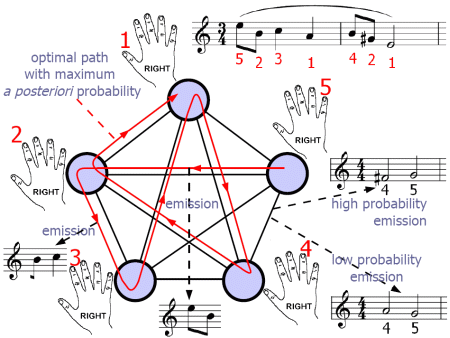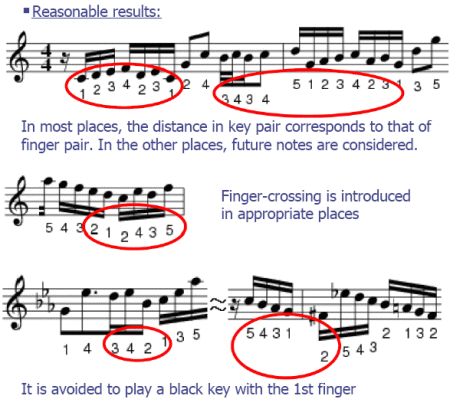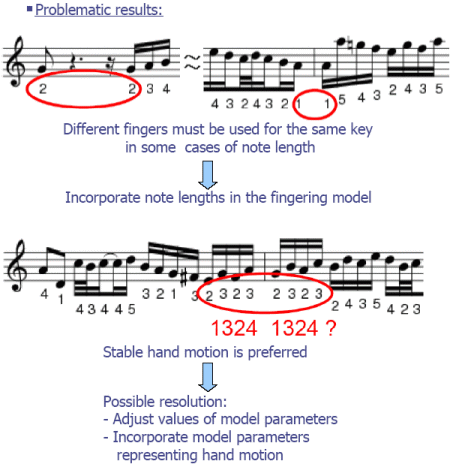
 Yuichiro Yonebayashi
Yuichiro Yonebayashi
 Hirokazu Kameoka
Hirokazu Kameoka
 Shigeki Sagayama
Shigeki Sagayama
[Goal] We propose an algorithm for the automatic determination of piano fingering based on Hidden Markov Models (HMMs). The goal is to determine the reasonable hand motion in a piano performance as well as to achieve highly reliable determination of piano fingering.

[Background] Fingering is a difficult problem, because when playing a note or chord, the performer needs to take into account the fact that he/she will need to be able to play the next note within the time assigned by the partition. Piano performers usually consider several constraints and rules in their decision, such as the fact that it is hard to move the 3rd and 4th or 4th and 5th fingers alternately, that it is often preferable to avoid playing a black key with the 1st finger, that they have to cross fingers when needed, etc. All these facts or rules need to be included consistently in a fingering determination model.
[Approach] Past research on automatic fingering determination mostly focus on the score-to-fingering conversion, for which a reasonable and mathematical formulation seems rather difficult. Instead, we focus on another aspect, fingering-to- performance conversion, which can be easily formulated mathematically in a probabilistic approach: if, for a given fingering, performed music can be generated by a probabilistic process, then determining the fingering for a certain performance amounts to solving an inverse probabilistic problem.
[Discussion] In our approach, the mechanism of fingering decision can be expressed qualitatively and quantitatively by the characteristics and the values of the model parameters. Moreover, reasonability and likelihood of the estimation process and result can be expressed as probabilities, where conflicts among applicable rules do not arise as in rule-based approaches.
 |
| Modeling of fingering with HMMs. |
[Applications] This algorithm is expected to be utilized for providing a model performance to piano learners. If considered as part of the motion planning of a robot piano player, the proposed approach may be widely applicable to more general robot's manipulation tasks using robot fingers. Computation of the required playing skill for given piano scores might be possible based on this algorithm, and one could then consider applying this computation to the automatic generation of a practice planning for piano scores, piano piece retrieval based on the required playing skills, or the development of judgement criteria as to whether an automatically composed (or transcribed) piano piece is actually playable. We hope the mathematical model we propose will be applied to other instruments such as guitar.
Keywords: Piano, fingering, decision, Hidden Markov Model, automatic.
The idea and results presented here were published first in Japanese [Yonebayashi2006ASJ03] and [Yonebayashi2006MUS05], and then in English [Yonebayashi2007IJCAI01].
We used piano scores of monophonic melodies in a single hand. Model parameters were tuned manually after an initial setting to intuitive values reflecting:
We obtained reasonable results as follows.

In the first sample, the distance in key pair corresponds to that of
finger pair in most places. In other places, future notes are
considered.
In the second sample, finger-crossing is introduced in appropriate places.
In the third sample, playing a black key with the 1st finger is properly
avoided.
There are problematic results as well, but we have prospective solutions for them.

In the first
sample, different fingers must be used for the same key depending
on the note length. This suggests that we have to incorporate note
lengths in the fingering model.
In the second sample, stable hand motion is preferred. A possible
solution would be to adjust values of the model parameters or to incorporate
model parameters representing hand motion.
For further information, please read article for [Yonebayashi2007IJCAI01].
[ Back to Lab Home ]